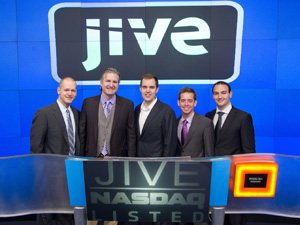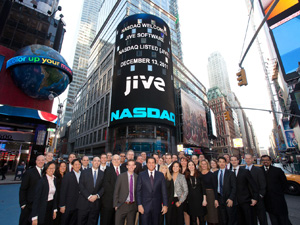UC San Diego Alumnus Nick Hill: Starting Small and 'Making it Big'
By Tiffany Fox, (858) 246-0353, tfox@ucsd.edu
San Diego, Calif., April 24, 2012 — To get an idea for the stunning career trajectory of University of California, San Diego alumnus Nick Hill, you need only read a single email thread originating in 2003.
|
The thread begins on May 20 of that year with an email from Hill to Ganz Chockalingam, a principal development engineer at the UC San Diego division of the California Institute for Telecommunications and Information Technology (Calit2). Chockalingam had advised Hill, then an electrical engineering undergrad, on a project for a course requirement called ECE 191, and Hill was wondering if his mentor could help him get a summer job as a post-graduate researcher at Calit2.
Hill went on to work for two years under Chockalingam’s direction as a programmer analyst for Calit2, where he helped develop the San Diego Wireless Traffic Report, an advanced traveler information system that allows commuters to personalize their traffic reports and review them on demand through their cell phones.
Scroll up that same email thread and there’s Chockalingam again, writing on Jan. 9 of this year to Calit2 Director Larry Smarr and director of the UCSD division, Ramesh Rao.
“Remember Nick Hill, who used to work in my group?” he writes in the email. “He worked at Calit2 for a few years, and then he joined Jive. They recently went IPO. He made it big.”
Hill, age 31, is now the Director of Product Design for Jive, a maker of social-networking software for large corporations. The company netted $120 million from its initial public offering (IPO) last December – valuing the Palo Alto-based company at nearly $679 million. As only the 10th employee hired at Jive (he started in 2005), Hill joined the company’s founders on the floor of the NASDAQ on the day of the IPO as they rang the opening bell to announce the start of trading, something he calls “a once-in-a-lifetime experience.”
Although he declines to disclose his earnings or how many Jive shares or options he owns, he does say, “like with most software companies, Jive wants its employees to possess a certain passion and pride for the company that can only come with some amount of ownership.”
“We originally had a profit-sharing bonus plan in place, but the company was very aggressive in reinvesting those earnings to drive growth. Eventually, we switched to a standard stock option plan to ensure that employees were invested in the growth along with the founders.”
Jive’s core battery of products allows employees in large firms to collaborate with one another, share work and build relationships on a secure, private network that allows for the free flow of information. Dubbed “Social Business Software,” the platform combines social networking and social media monitoring with collaboration software to “harness the collective intelligence of an organization,” thereby subverting the traditional enterprise approach, which reinforces hierarchies and information silos.
“There’s a whole generation coming into the workforce who are not going to be satisfied with the status quo,” notes Hill. “They expect the tools they will be given at work to rival those they use in their personal lives. Email is overused in the enterprise — it was never intended to help us work together on documents, ideas and presentations, to find information or experts. There is a better way.”
He continues: “People are the center of our application and we leverage the social graph to help produce a more productive workforce. We’ve always used our own product internally, and it’s allowed us to do a lot more collaboration between departments. Our CEO blogs regularly, keeping the company informed and aligned. New employees are able to ramp up in days rather than weeks. It’s about knowledge sharing, efficiency, openness and collaboration.”
Famed Menlo Park venture capital firms Sequoia Capital and Kleiner Perkins Caulfield & Byers (both big investors in Google), invested $57 million in Jive between 2007 and 2010. They did not sell any of their substantial stakes in the IPO, and Sequoia remains Jive’s largest shareholder, with nearly 30 percent of the company. Jive’s clients include T-Mobile, Alcatel-Lucent, Avon Products, Hitachi Data Systems, Prudential Real Estate Investors and the World Bank.
All dollar signs aside, Hill is quick to point out that his passion is and always has been building amazing products — a mentality he credits to his experiences working at Calit2.
“My project for ECE 191 was the first software application I ever wrote, and it taught me that even if you’re a hardware guy, knowing software is an incredibly valuable skill,” he says. “Working with Ganz gave me air cover to dive in deep and learn the software world, and the Wireless Traffic Report was really where I was introduced to web application development.”
Chockalingam remarks that, “Though Nick had no prior software experience, it was amazing to see how quickly he came up to speed. He soaked up things like a sponge and things just seemed to click for him once he saw the practical applications of software. He was a fun guy to have in the group as well. When Nick announced he was getting married (to UCSD alumna Allison Hill, née Milbank) and confessed to me that he was a tad nervous, I suggested that he should hang around with happily married men. He responded with ‘but such men are so hard to find’!”
Still, Hill says he was surprised to get the job at Jive — his first out of Calit2 — back in 2005, after his college roommate, fellow UC San Diego Patrick Lightbody (also a computer science and engineering major) recruited him.
“Looking back, I was very fortunate to get the job because I still didn’t know much software at the time. I remember reading two or three programming books the night before I started, thinking ‘what did I get myself into?’
|
“But in the software world, it’s not about what you’ve read — what’s important is if you’ve built something, and I knew I had done that,” he adds. “That’s the beauty of software: All you need is yourself, a computer and time, and you can create amazing things. You’re going to make mistakes, but you can’t let fear stop you.”
Hill’s fearlessness and his passion for Jive’s products have helped him thrive at the company. He originally began at Jive as a professional services engineer, building customizations for customers on top of core products. Within six months he was promoted to engineer on the core engineering team, where he was one of five engineers to work on Clearspace, one of Jive’s flagship products. Since then, he has served as the company’s engineering lead and engineering manager and Hiil says he has interviewed more than 200 aspiring engineers.
More recently, Hill took the initiative to start a product design group within Jive, because he felt “there was a gap, a functional design piece missing.”
“Product management would define customer problems and business requirements, but we needed to look at the way the product was actually going to function and behave; how we were going to solve problems. I wanted to make sure our products were well-thought-through, that they were the best products possible, so we started designing prototypes and doing usability testing.”
Adds Hill: “That’s the other thing about Calit2 that really shaped my experience at Jive: A lot of what we did at Calit2 was proof-of-concept. I got really, really good at prototyping and iterating things and getting them to work quickly. It was more about showcasing what the possibilities were, and that love for building things and getting them to work is what’s driven me.”
Hill says another driving force in his career has been his willingness to embrace failure — a philosophy he wishes all engineers would adopt.
“So much of personal success has to do with not being afraid to take a chance,” he says. “Nothing should be easy. If you don't fail some of the time then you aren't pushing hard enough. Those failures are usually the best learning tools.”
Media Contacts
Tiffany Fox, (858) 246-0353, tfox@ucsd.edu
Related Links



